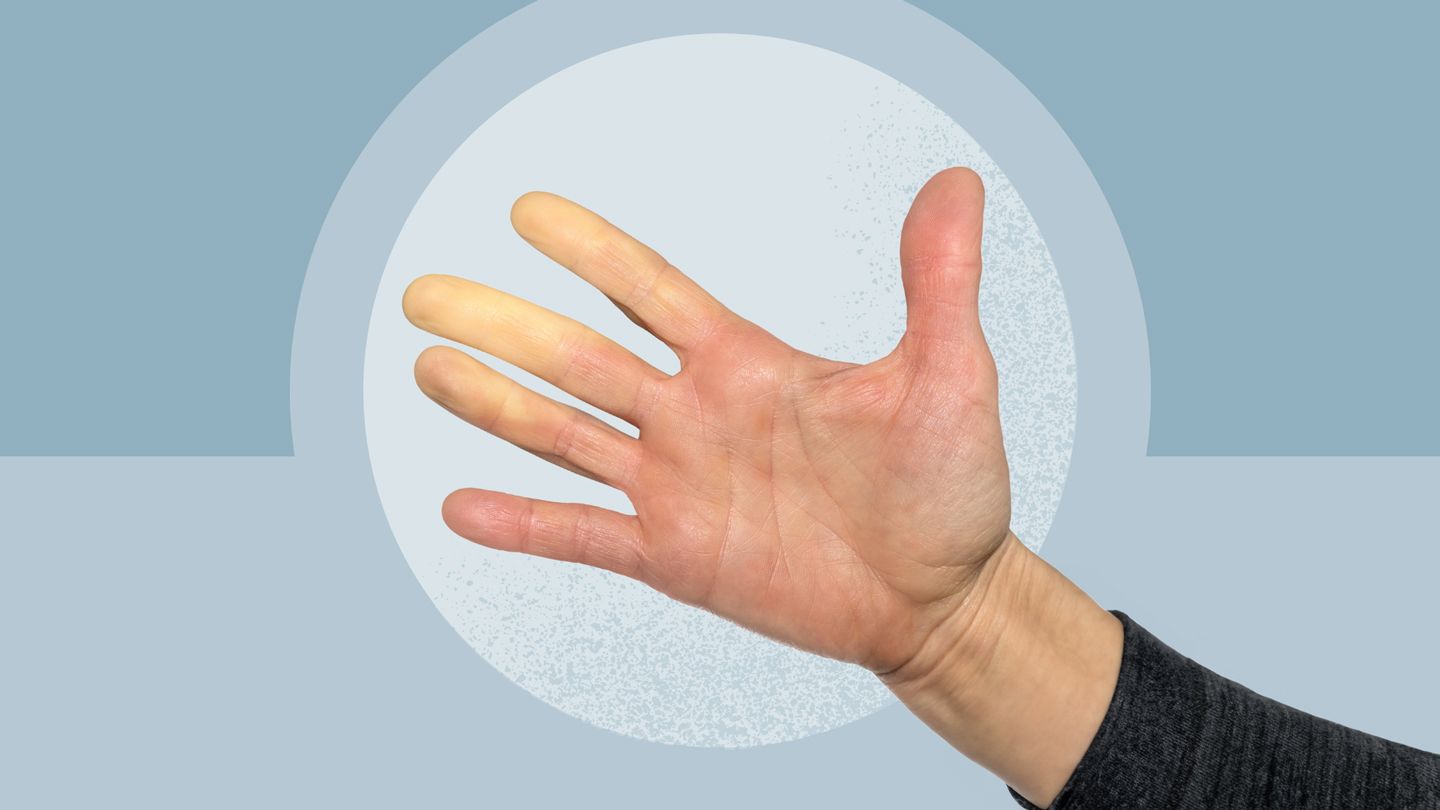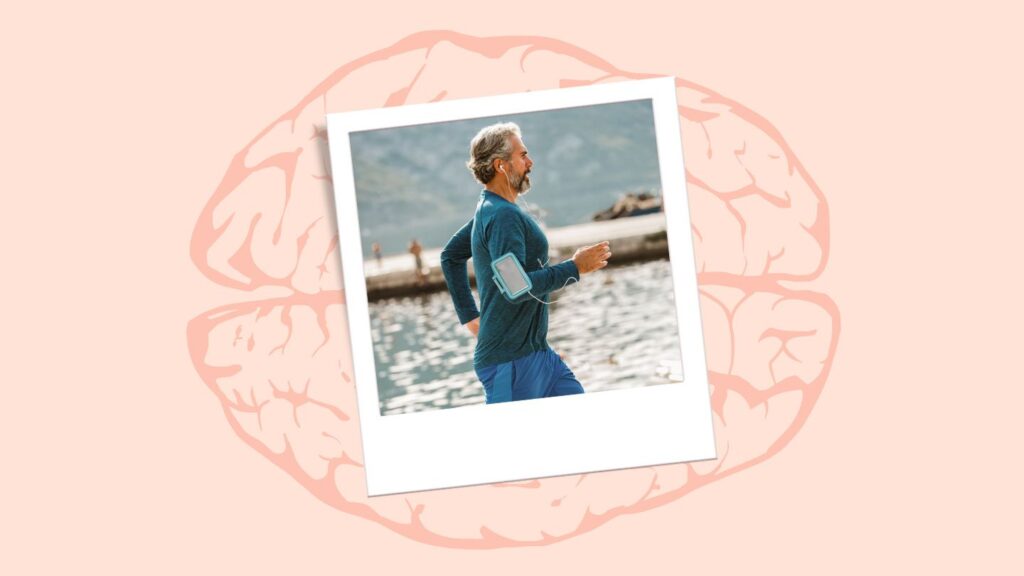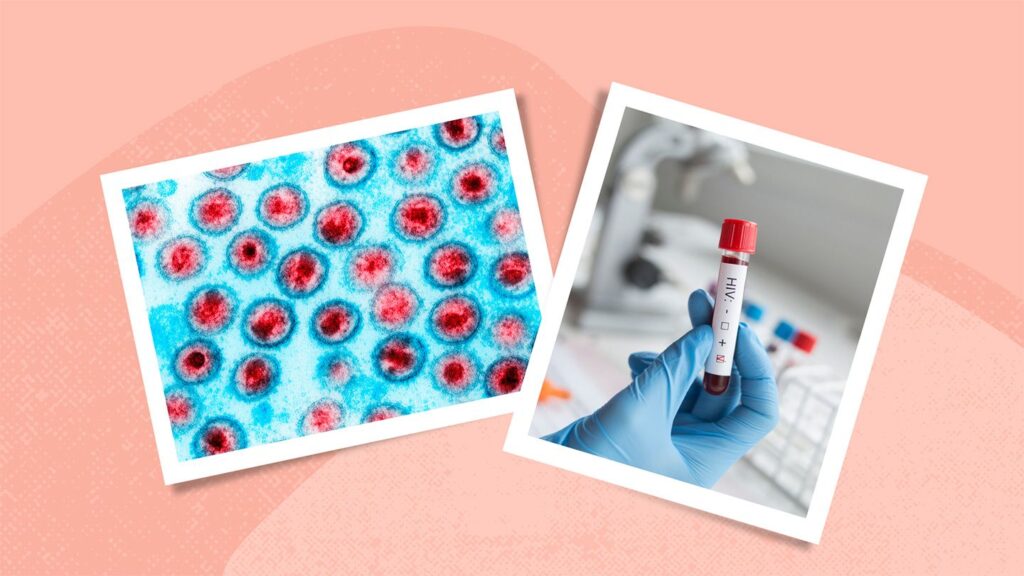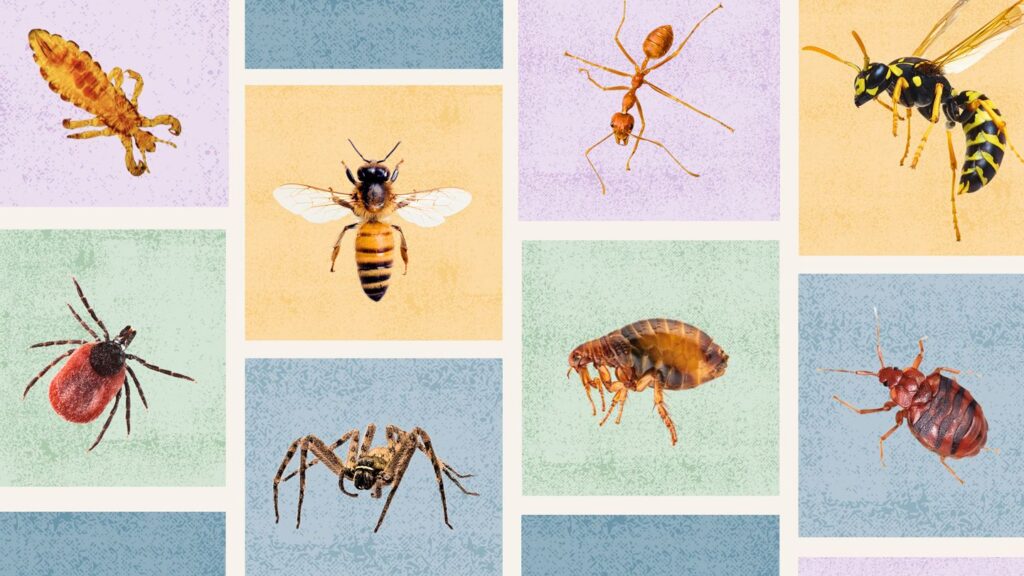In the face of cold temperatures, do your fingers and toes often turn white, blue, or red with sensations of pins and needles or numbness? If so, you may have Raynaud’s syndrome — a common condition that affects people worldwide.
Overview Overview Raynaud’s syndrome, which is also called Raynaud’s phenomenon or Raynaud’s disease, is a disease that affects blood circulation. If you have the condition, it causes blood vessels to narrow more than usual in reaction to cold temperatures, causing your extremities (namely your fingers and toes) to turn pale and feel numb. “The pain and numbness and tingling can occur in the fingers — most commonly — in different situations; for example, when you’re holding a cold beverage or opening the freezer door at the grocery aisle,” says Ambreesh Chawla, MD , a rheumatologist at Cleveland Clinic. The sensation is often somewhere between uncomfortable and painful, says Daniel Furst, MD , a professor of rheumatology at the University of California Los Angeles and University of Seattle, and spokesperson for the Raynaud’s Association. Some people simply live with the symptoms. But treatment and lifestyle changes can help, says Furst. “Understanding Raynaud’s will lead to treatment that is often very successful.”
Signs and Symptoms of Raynaud’s Syndrome Symptoms Raynaud’s syndrome occurs in episodes that last about 15 minutes or so. It affects certain parts of the body, namely the fingers and toes, when they’re exposed to cold temperatures, such as from holding frozen or cold items or shifting from humid temperatures outdoors to icy, cold air conditioning indoors, says Dr. Furst. Symptoms during an “attack” or episode include:e60dc2a1-f33c-4a05-9b50-8e3e8e59762999fe67f4-6c8d-4555-9ce0-f2375abc3138 Color Changes As your blood vessels constrict limiting circulation to your extremities, you’ll notice your skin change color to a pale blue to red or white. All people do not necessarily experience all three color changes. Feeling Cold and Numbness Because your fingers, toes, ears, nose, or other parts of the body aren’t receiving oxygen-rich blood, they’ll feel cold, maybe even numb. Warmth Tingling or Throbbing Towards the end of an episode, your blood circulation will return, and the once-cold, blue parts of your body may feel sensations of tingling or throbbing as they warm back up again. Skin Ulcers or Gangrene During extended or frequent attacks, your skin may develop painful sores, especially on your fingertips. In worst case scenarios, this lack of circulation and oxygen to your fingers and toes can lead to gangrene, or tissue death. The hallmark symptoms of Raynaud’s are the color changes in the hands and toes, Furst says. “You’ll notice blue because there’s not enough oxygen to the fingers at the time, then white because the blood vessels have completely shut off and there’s no blood flow. Finally, red when there’s a compensatory increase of the blood flow.” For some people, it’s not always all three and it’s not always in that order, but symptoms of pain, tingling, and numbness usually accompany these color changes. An attack typically lasts a few minutes but may carry on for hours with the pain varying from person-to-person. But for most people, the symptoms are mild and not dangerous.
Causes and Risk Factors of Raynaud’s Syndrome Causes There are two main types of Raynaud’s disease: primary Raynaud’s and secondary Raynaud’s. Causes of Primary Raynaud’s Primary Raynaud’s, also called Raynaud’s disease, is the most common form, Dr. Chawla explains. It affects about 5 percent of the general population.e60dc2a1-f33c-4a05-9b50-8e3e8e5976297eeedc6e-8391-4695-93f1-8aca83531bfc It isn’t caused by another medical condition, it’s unclear why it occurs, and it tends to be milder with episodes that clear on their own, so treatment isn’t often required. Causes of Secondary Raynaud’s Secondary Raynaud’s, also known as Raynaud’s phenomenon, develops because of another health condition or disease, or because of certain behaviors. Although it’s less common, it tends to be more serious. Causes of secondary Raynaud’s:e60dc2a1-f33c-4a05-9b50-8e3e8e59762965a75712-cd99-4074-a1cc-f0ac49c4cd03 Connective Tissue Diseases Some people with Raynaud’s have a rare disease called scleroderma that causes hardening and scarring of the skin. Other diseases that affect connective tissues that also increase risk of Raynaud’s include lupus , rheumatoid arthritis , and Sjogren’s syndrome . Diseases in the Arteries If you have a buildup of fatty deposits in the blood vessels that feed the heart or a disorder that causes blood vessels in the hands and feet to become inflamed, you may be susceptible to secondary Raynaud’s. Carpal Tunnel Syndrome If you have carpal tunnel syndrome (one of the most common hand conditions, which involves pressure on the major nerves in the hand) you’ll feel the same sensations of numbness and pain that can make the hand react more to cold temperatures. Repeated Actions or Vibration If you’re often typing, playing the piano, or in a profession where you frequently use vibrating tools (such as a jackhammer), you may be at risk of developing secondary Raynaud’s. Smoking Smoking can cause Raynaud’s because over time, smoking can lead to narrowing of blood vessels. Certain Medications Some medications — namely beta blockers for high blood pressure , migraine medication, attention deficit/hyperactivity disorder medication, and certain cancer medications — can increase risk of secondary Raynaud’s too. “The idea here is simple: Anything that causes the blood vessels to become overreactive to the environment and anything that can cut off oxygen supply in the bloodstream can cause Raynaud’s,” Furst says.
How Is Raynaud’s Disease Diagnosed? Diagnosis If you’re grappling with symptoms, talk to your healthcare provider to get diagnosed. He or she may refer you to a rheumatologist or vascular medicine subspecialist, Chawla says. “It’s a clinical diagnosis, meaning it’s diagnosed by the clinician based on history and an exam. Taking photographs or videos of your Raynaud’s attacks and keeping a diary of your symptoms to show your doctor can help in expediting a diagnosis,” Chawla says. Your doctor may also conduct a cold challenge test to check for color changes in the hands and fingers, Furst notes. “We ask patients to put their hands into ice water and hold it for 90 seconds. And sometimes that brings it on.” Doctors then conduct a capillaroscopy, which looks at the tiniest blood vessels at the base of the fingers. “That can give us a hint as to whether someone might have secondary Raynaud’s.” They also rely on blood tests, according to Mayo Clinic, including:e60dc2a1-f33c-4a05-9b50-8e3e8e597629297e84e0-67a2-4e62-9f97-ae3e1f1b3116 Antinuclear Antibodies (ANA) Test A positive result here indicates that your immune system is mistakenly attacking body tissue, triggering an autoimmune reaction. It suggests you might have connective tissue diseases or other autoimmune disorders. Erythrocyte Sedimentation Rate (ESR) This test measures the rate at which red blood cells fall to the bottom of a tube. A faster than typical rate might signal an inflammatory or autoimmune disease. These blood tests are often done to check if there are triggering factors or underlying systemic disease at play, Chawla says.
How Long Does Raynaud’s Disease Last? Duration Overall, Raynaud’s is a chronic condition but it’s intermittent in nature, meaning it’ll come and go. If you have secondary Raynaud’s syndrome, your prognosis depends on your underlying disease and how it’s managed. “Both types are typically improved in the summer months and exacerbated in winter months, worse in duration, severity and frequency of attacks,” Chawla says. But for most people living with Raynaud’s syndrome, know that the outlook is positive. Symptoms, in the primary case, may be inconvenient but they aren’t serious or life-threatening. You may have to make some lifestyle adjustments to avoid triggering episodes. In 10 percent of patients, attacks disappear completely, Chawla says.
Treatment and Medication Options for Raynaud’s Disease Treatment There is no cure for Raynaud’s disease, however multiple avenues of treatment are available to help lessen the number of episodes you have depending on the severity or treat your skin when it develops sores. Additionally, simple lifestyle and behavior changes can greatly improve symptoms and reduce attacks. (More on lifestyle tips for managing the condition below.) Medication Options Depending on what’s causing your symptoms, medication might help. These include: Calcium Channel Blockers These drugs open small blood vessels in the hands and feet, allowing for circulation. They also help with healing sores if you develop them in severe cases on your fingers or toes. Examples include nifedipine (Procardia) , amlodipine (Norvasc) , felodipine , and isradipine.e60dc2a1-f33c-4a05-9b50-8e3e8e597629664c3f1a-9ca7-43f3-a109-b075cb30d882 Vasodilators These drugs relax blood vessels. They include the high blood pressure drug losartan (Cozaar) , the erectile dysfunction medicine sildenafil (Viagra, Revatio) , the antidepressant fluoxetine (Prozac) and a class of medicines called prostaglandins. e60dc2a1-f33c-4a05-9b50-8e3e8e597629664c3f1a-9ca7-43f3-a109-b075cb30d882 Nitroglycerin Skin Ointment This is a cream that you apply to your fingers to help heal skin ulcers.e60dc2a1-f33c-4a05-9b50-8e3e8e597629020aee8d-c229-43d0-b0b6-3f00e53767ee Surgery and Other Medical Procedures Patients with severe Raynaud’s disease who are encountering multiple episodes that linger or lead to finger sores may need to speak to their doctor for a more aggressive treatment approach. This may include: Nerve Surgery You may be a candidate for nerve surgery, in which small incisions are made in your hands or feet, where episodes occur, to remove tiny nerves around the blood vessels. Doing this ensures you have fewer and shorter attacks because your nerves have been lessened.e60dc2a1-f33c-4a05-9b50-8e3e8e59762930515ab9-12a6-4286-ab13-1f0d137158e7 Chemical Injections Shots of numbing medicines or onabotulinumtoxinA (Botox) can block nerves in affected hands or feet. Some people need to have this more than once if symptoms remain or return.e60dc2a1-f33c-4a05-9b50-8e3e8e597629664c3f1a-9ca7-43f3-a109-b075cb30d882
Prevention of Raynaud’s Disease Prevention There’s nothing you can do to prevent Raynaud’s syndrome. But you can try to prevent episodes by learning your triggers and adjusting your lifestyle to avoid them, Furst says. Secondary Raynaud’s is caused by an underlying disease or condition, such as connective tissue diseases, cancer, lupus or hypothyroidism. That’s why in cases of secondary Raynaud’s, your healthcare providers will try to treat the underlying disease first, Furst says. They may, however, adjust your medications or recommend lifestyle changes to help you lessen the severity of Raynaud’s episodes, or prevent those symptoms entirely.
Lifestyle Changes for Raynaud’s Lifestyle Changes Changes in temperature, stress and anxiety, smoking can all bring on an attack in people with Raynaud’s. The good news is that some of these things are avoidable. And in other cases, taking simple steps can help reduce or reduce the intensity of attacks, Furst says. To help lessen the frequency and intensity of Raynaud’s attacks, consider: Quitting Smoking Smoking, vaping, or breathing in someone else’s smoke tightens blood vessels. This causes skin temperature to drop, which may trigger an episode.e60dc2a1-f33c-4a05-9b50-8e3e8e5976291fa73e75-f460-47c9-a7ab-43fd309297c9 Exercising Aside from being great for your cardiovascular health, exercise increases blood flow, which will help with circulation. Talk to your doctor before exercising outdoors in the cold.e60dc2a1-f33c-4a05-9b50-8e3e8e5976292e599a83-ac71-4f49-abc0-c6ac9ff2741d Managing Stress Stress can trigger Raynaud’s, just like cold temperatures can. When the brain perceives that your body is under stress, it kicks into fight-or-flight mode, constricting blood vessels in the extremities to send blood to the body’s vital organs to protect them — which can in turn trigger a Raynaud’s episode.e60dc2a1-f33c-4a05-9b50-8e3e8e597629281e01e5-ea11-4411-9f7c-ced8956c973d Making time to unwind during your day on a regular basis, whether that’s through yoga , meditation , mindfulness , or other activities, can help keep baseline stress levels lower. And having an arsenal of relaxation and stress-busting techniques at the ready can help in the moments stress gets dialed up. Regularly doing things like yoga and meditation really can help people lessen their natural stress threshold, so that stress response gets turned on less frequently (which lessens Raynaud’s symptoms), Furst says. “That’s teachable and doesn’t require medication.” Avoiding Rapidly Changing Temperatures Try not to go quickly from heat to air conditioning, and adjust your thermostat so your home or office is a comfortable temperature. When you’re in the grocery store, limit your time in air conditioning and cold spaces if you suffer from severe episodes of Raynaud’s.e60dc2a1-f33c-4a05-9b50-8e3e8e597629472bc99f-d3fe-4a7a-b6ff-45fb06e11f79 Dressing Warmly In winter temperatures, keep your whole body warm, but especially your hands, feet and head. Furst recommends wearing several layers of loose clothing so you can remove layers as needed. Don’t forget mittens and a hat. Keeping extremities covered is important, because these body parts are most vulnerable to Raynaud’s attacks.e60dc2a1-f33c-4a05-9b50-8e3e8e59762913c7a371-f276-458d-8fe0-2acf99b2c092 Limiting Use of Tools That Vibrate If you know that tools, such as jackhammers or drills, cause episodes of Raynaud’s for you, steer away from them. This applies to other repetitive motions, like playing the piano or typing, Furst says.
Complications of Raynaud’s Disease Complications The main complication of Raynaud’s disease is growing sores on your finger pads. While this is a rarity, if it does happen, the sores could progress to gangrene. Gangrene is a serious condition that occurs when tissue dies due to a lack of blood flow or a bacterial infection.e60dc2a1-f33c-4a05-9b50-8e3e8e597629653363ba-1ebd-45a2-a081-035788401de5 It can require amputation of the affected area to prevent its spread or to save the rest of a limb. Furst notes that this is a severe and rare complication, however, and not common in people with Raynaud’s disease.
Research and Statistics: How Many People Have Raynaud’s Disease? Research and Statistics Roughly 5 to 10 percent of Americans suffer from Raynaud’s.e60dc2a1-f33c-4a05-9b50-8e3e8e59762989bb203e-c9ef-40a2-85ed-d1eb27514959 While both men and women suffer from Raynaud’s, women are 9 times more likely to be affected. The primary form of Raynaud’s disease is the most common type.e60dc2a1-f33c-4a05-9b50-8e3e8e597629cad79411-65c8-481a-aba7-9cf20cf9c22f It often starts between ages 15 and 25, it’s less severe than secondary Raynaud’s, and there is no clear cause or correlation to other conditions. Secondary Raynaud’s is tied to other conditions, and often develops later in midlife between the ages of 35 and 40.
The Takeaway Raynaud’s disease is an issue that can cause your fingers, toes and other extremities to turn cold and numb when they’re exposed to cool temperatures. They may feel tingling as blood circulation returns after an episode. The condition can be caused on its own or as a result of another condition that affects circulation or connective tissues, such as lupus or Sjogren’s disease. Overall, lifestyle adjustments can help keep episodes at bay or decrease their length while medication can also help to manage symptoms.
Resources We Trust Raynaud’s Association: What Is Raynaud’s?National Institutes of Health: Raynaud’s PhenomenonCleveland Clinic: Raynaud’s SyndromeMayo Clinic: Raynaud’s SyndromeJohns Hopkins Medicine: Raynaud’s Phenomenon
Raynaud’s Syndrome



